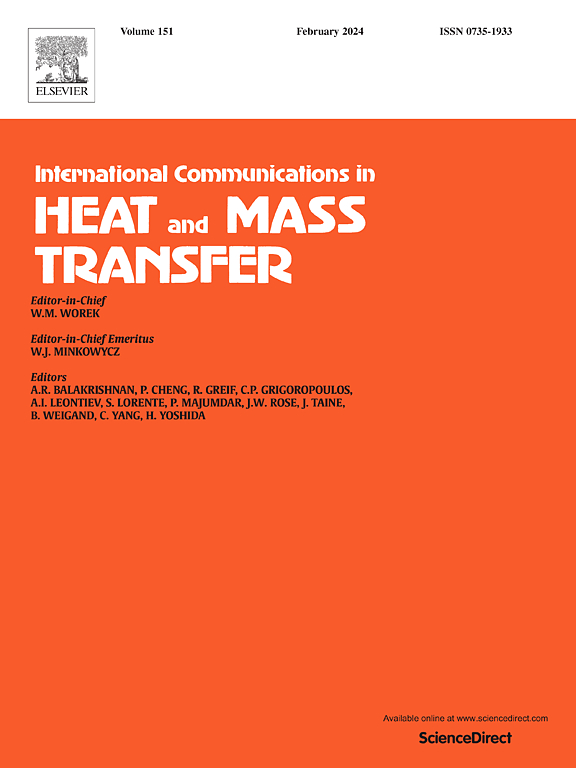Unsteady hydromagnetic motion of non-miscible fluids via an inclined co-axial porous cylinders
IF 6.4
2区 工程技术
Q1 MECHANICS
International Communications in Heat and Mass Transfer
Pub Date : 2025-07-21
DOI:10.1016/j.icheatmasstransfer.2025.109334
引用次数: 0
Abstract
It is known from the literature that there are several studies that have examined the motion of hydromagnetic fluid through various conduits under the assumption that induced magnetic and electric fields are negligible. However, when an electrically conducting fluid flows under the influence of an external magnetic field, then an electromotive force (EMF) is induced. This EMF pushes the charges, creating an induced current which generate its own magnetic field. These EMFs and induced currents further increased or decreased the separation of charges within the fluid element to achieve the electrical equilibrium state and hence affect the induced electric field within the fluid element. These induced electric and magnetic fields are inherently linked to the fluid motion and become significant when the magnetic Reynolds number is sufficiently large. The motivation behind the present work lies in understanding the complex interactions of magnetic fields with the motion of fluids when both the induced electric and magnetic fields are strongly coupled with the fluid flow. This work have investigated the unsteady hydrodynamic flow of electrically conducting immiscible micropolar–Newtonian fluids through an annular domain formed by two concentric, inclined cylinders and filled with porous media, in the presence of induced magnetic and electric fields. This model presents convection flow of immiscible fluids under the influence of a significant magnetic Reynolds number with thermal relaxation time and employs the Navier’s slip conditions for velocity at the cylinder’s boundaries. The transport of non-miscible fluids within a porous medium under the existence of externally imposed uniform magnetic field is governed by the Brinkman model, and the governing differential equations associated with the model are solved by the Laplace Transform Finite Difference (LTFD) method, along with the Stehfest algorithm for numerical inversion. The numerical solution of hydrodynamic properties, along with induced magnetic and electric fields, is displayed for various emerging parameters, such as permeability parameter, Hartmann number, magnetic Reynolds number, Prandtl number, and slip parameter. The noteworthy findings of the present investigation are that the impact of the magnetic Reynolds number on the immiscible fluids’ velocity is negligible at the interface region, and the influence of the magnetic interactions parameter is inversely proportional to the induced magnetic field. This study also concluded that by enhancing the Grashof number, the pressure gradient and flow rate are increased. Further, this study concluded that by increasing 50% of the Prandtl number, the interfacial temperature of non-miscible fluids is decreased by 35.32%, while an increase in thermal relaxation time results in an approximate 33.01% enhancement in the rate of heat transfer. The results of the present study may be applicable in liquid-metal cooling, fuel cells, and nuclear reactor cooling loops where managing convective and electromagnetic interactions in immiscible fluids through porous media systems is crucial.
非混相流体在倾斜共轴多孔圆柱体中的非定常磁运动
从文献中得知,有几项研究在假定感应磁场和电场可以忽略的情况下,考察了磁流体在各种管道中的运动。然而,当导电流体在外部磁场的影响下流动时,就会产生电动势(EMF)。这种电动势推动电荷,产生感应电流,产生自己的磁场。这些电磁场和感应电流进一步增加或减少流体元件内电荷的分离,以达到电平衡状态,从而影响流体元件内的感应电场。这些感应电场和磁场与流体运动有着内在的联系,当磁雷诺数足够大时,这些感应电场和磁场就变得显著。本工作的动机在于理解当感应电场和磁场都与流体流动强烈耦合时,磁场与流体运动的复杂相互作用。本文研究了在感应磁场和电场的作用下,导电非混相微极-牛顿流体在由两个同心倾斜圆柱体构成的环形区域内的非定常流动,该环形区域内填充有多孔介质。该模型描述了在显著磁雷诺数和热松弛时间的影响下非混相流体的对流流动,并采用纳维耶滑移条件计算圆柱边界处的速度。采用Brinkman模型对多孔介质中非混相流体在外加均匀磁场作用下的输运进行控制,并采用Laplace变换有限差分(LTFD)方法求解该模型的控制微分方程,采用Stehfest算法进行数值反演。对于各种新出现的参数,如磁导率参数、哈特曼数、磁雷诺数、普朗特数和滑移参数,显示了水动力特性的数值解以及感应磁场和电场。值得注意的是,在界面区域,磁雷诺数对非混相流体速度的影响可以忽略不计,磁相互作用参数的影响与感应磁场成反比。研究还发现,增大Grashof数可以提高压力梯度和流量。此外,本研究得出,当普朗特数增加50%时,非混相流体的界面温度降低了35.32%,而热松弛时间的增加导致换热率提高了约33.01%。本研究的结果可能适用于液体金属冷却、燃料电池和核反应堆冷却回路,在这些领域,通过多孔介质系统控制非混相流体中的对流和电磁相互作用是至关重要的。
本文章由计算机程序翻译,如有差异,请以英文原文为准。
求助全文
约1分钟内获得全文
求助全文
来源期刊
CiteScore
11.00
自引率
10.00%
发文量
648
审稿时长
32 days
期刊介绍:
International Communications in Heat and Mass Transfer serves as a world forum for the rapid dissemination of new ideas, new measurement techniques, preliminary findings of ongoing investigations, discussions, and criticisms in the field of heat and mass transfer. Two types of manuscript will be considered for publication: communications (short reports of new work or discussions of work which has already been published) and summaries (abstracts of reports, theses or manuscripts which are too long for publication in full). Together with its companion publication, International Journal of Heat and Mass Transfer, with which it shares the same Board of Editors, this journal is read by research workers and engineers throughout the world.

 求助内容:
求助内容: 应助结果提醒方式:
应助结果提醒方式:


